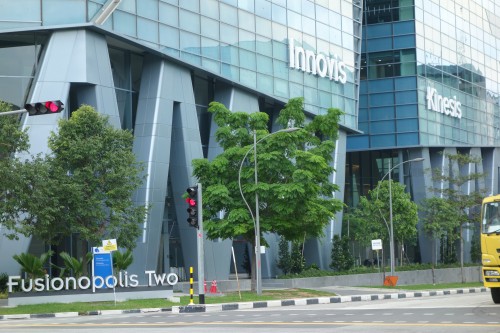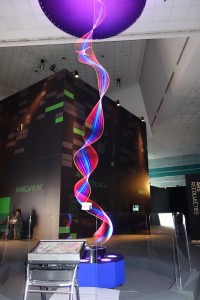
Golden future – the second phase of Singapore’s giant Fusionopolis R&D centre.
By Robert P Crease in Singapore
I’ve landed in Singapore shortly before the 50th anniversary of the nation’s independence – Sunday 9 August is the official date. The event that brought me was a conference entitled “60 Years of Yang–Mills Gauge Field Theories”, the opening day of which on Monday 25 May featured speeches by C N Yang, who shared the 1957 Nobel Prize for Physics, as well as David Gross – the 2004 Nobel-prize winner. I spoke on Wednesday morning.
But the conference isn’t the only physics-related event scheduled in Singapore’s jubilee year. Another is the opening of Fusionopolis II, the second phase of an innovative research and development (R&D) hub funded by the government’s Agency for Science and Technology Research (A*STAR). Phase one opened seven years ago – you can relive Physics World news editor Michael Banks’s experiences here; phase two is slated to open on 19 October. The initiative aims to supercharge Singapore’s research ecology by putting in close proximity materials-science research institutes, industrial research centres, and an international collection of eminent universities.
On Saturday afternoon I clambered to the top of Fusionopolis I with Augustine Koh, a student who has spent nine months working at the hub’s Advanced Digital Sciences Center (ADSC), a collaboration between A*STAR and the University of Illinois at Urbana-Champaign (UIUC). We watched as workers put the finishing touches to one of the new buildings of Fusionopolis II.
Koh, who enters UIUC in August as an undergraduate major in physics and computer science, explained that Fusionopolis I and II are products of Singapore’s top-down approach to R&D planning. “It’s Singapore’s way of trying to create a Silicon Valley,” he said, “helping the country to make a transition from a manufacturing economy to one focused on high-end technology.”
Fusionopolis will have even more of a physics focus than Fusionopolis I, Koh explained. “The idea is to build a critical mass of research talent that will spin off into actual applications by industries,” he said. For example, one of the first tenants of the new building will be the National University of Singapore’s A*STAR-funded Institute of Materials Research and Engineering.

Move on up – the “Kinetic Light Sculpture” at the Science Centre Singapore.
I’ll not only miss the opening of Fusionopolis II, but also the “Science Jubilee” on 4 September – an open-house at Fusionopolis celebrating 50 years of science in Singapore. I’ll also miss the Singapore Science Conference on 16–17 September, which will bring together representatives of Singapore’s universities to sing the praises of that half-century of science.
Meanwhile, on Friday evening I attended the opening of “InterPlay: When Science Meets Art” – an exhibition at the Science Centre Singapore that runs until 16 August. Its central and most striking exhibit was “Kinetic Light Sculpture” – a multicoloured ribbon that constantly changes colours and shapes as it dances from the floor eight metres up to the ceiling.
“I call it chromostrobic,” the artist, Paul Friedlander, told me. “It’s actually only lit by one colour at a time, but because of the strobes and visual retention it looks multicolored!” Friedlander said he had studied physics and maths at Sussex University in the UK but one day in London he was hooked by an exhibition of kinetic sculpture and has been an artist ever since. He was proud of having designed the software for the interactive panel with which visitors can change the colours and intensities of the six groups of 300 strobe lights that govern the colours.
Guidelines
Show/hide formatting guidelines
this text was deletedwhere people live in harmony with nature and animals</q>
Some text